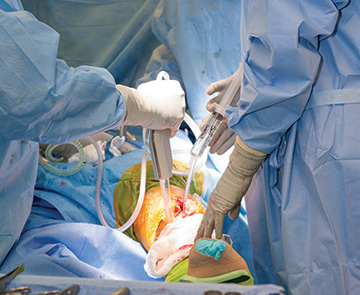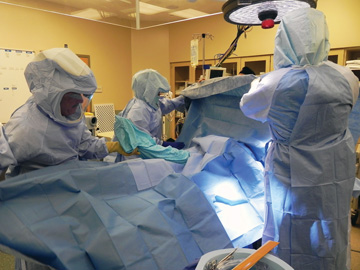It takes the entire OR team, including surgeons, anesthesiologists, nurses and OR staff to work together to complete these complex surgeries.
 Dr. Alyssa Hamman
Dr. Alyssa Hamman
As total joints procedures continue to take hold in the outpatient surgery environment, OR teams work closely together to make these surgeries a success. Close attention to qualifying patients for the surgeries along with strategies regarding techniques and technologies utilized in the ambulatory surgery setting combine to provide safe and efficient surgeries. We spoke to Dr. Alyssa Hamman, an anesthesiologist from Denver, Colorado who is a consultant with Stryker, to get her thoughts about the role of the anesthesiologist in an orthopedic ASC.
Q: Does the role of the anesthesiologist differ from a hospital setting in an ASC?
While the role of the anesthesiologist is always to safely provide expert preoperative, intraoperative and postoperative care, there are some distinct differences between the hospital and ASC. Most notably, the ASC demands meticulous patient selection to ensure a successful and safe surgery. Anesthesia technique may also differ to ensure an expedient but appropriate PACU discharge.
Q: Do outpatient surgeries, including total joints and other complex surgeries, require special planning by the surgical team?
Absolutely. The more complex the surgery, the more the anesthesiologist needs to communicate and plan with the surgical team. Specific considerations include planned operative time and plans for post-operative pain management. Longer operative times usually result in longer PACU times, which can affect the flow of the ASC. Post-operative pain management can also affect PACU time, so regional anesthesia techniques and other narcotic-sparing techniques are important tools in the outpatient setting. However, certain anesthesia techniques commonly used in orthopedic procedures, such as spinal anesthetics, are usually not appropriate in the ambulatory setting given the prolonged recovery time and the risk of urinary retention. Overall, consistency and communication within the team will result in a smooth experience for the patient and the surgical team.
Q: What has changed for anesthesiologists in the outpatient setting since you started working there?
The breadth and depth of procedures have increased, and we are also seeing patients with more comorbidities and complex medical histories in our ASCs. When I first started working in an ASC during residency, orthopedic cases mostly consisted of quick arthroscopies. Now, total joint replacements are becoming the norm. Whereas a bilateral mastectomy used to require a 2- to 3-day hospital stay, now we do these surgeries in the outpatient setting. Neurosurgical procedures such as ACDFs are commonplace in the ASC, and hysterectomies can go home the same day. Innovations in both surgical and anesthetic techniques have allowed us to expand what we can do in an ASC. Overall, most surgeons seem to really enjoy working in an ASC setting and will often "push the envelope" to try and avoid taking a case to the hospital! ASCs are more efficient, surgeons can't be "bumped" for an emergency (which happens often in the hospital), surgeons know and trust the smaller staff at an ASC, and patients are usually eager to go home. As an anesthesiologist, part of my job in the ASC is to balance surgeon preference with reasonable patient selection.
Q: From an anesthesia perspective, how critical is patient selection when surgeons are making the choice to operate in an outpatient setting?
Patient selection is absolutely critical to a successful ASC. We often don't have preoperative diagnostics (such as EKGs and labs) in an ASC, so those items need to be evaluated and optimized before the patient walks in the door. Intraoperatively, we need to ensure that we can safely care for patients given the equipment and technologies we have at the ASC, which may be different from the hospital. And lastly, careful patient selection should result in fast and safe PACU discharge. For example, a patient with severe OSA might do well intraoperatively, but if he stays in the PACU for 6 hours due to hypoxia and hypoventilation issues, then that can interrupt the flow of patients and staffing for the entire center.
Q: How do you think the migration of surgeries to the outpatient setting is beneficial for patients?
Outpatient surgery is beneficial to patients in terms of cost, comfort and avoidance of hospital specific complications. If it's safe, most patients would prefer to recover in the comfort of their own home surrounded by family or friends. Patients get more rest at home, and familiar surroundings can be critical to older patients to help avoid postoperative delirium and perhaps longer-term neurocognitive issues. Avoiding hospital acquired infections is also a bonus.
Q: How can anesthesiologists get more comfortable in the ASC or HOPD?
Experience in a well-run ASC is crucial to increase anesthesiologist comfort. Additionally, working as a team with the surgeons and administrators can ensure that the anesthesiologists' concerns are being addressed so that she can provide the best anesthesia care possible. The Society for Ambulatory Anesthesia (SAMBA) is also a great resource. As a member you can access many clinical practice guidelines and connect with other ambulatory anesthesia colleagues.
Q: What is your favorite part of being on the surgical team in an ASC or HOPD?
Ambulatory anesthesia is an evolving and challenging skill, and one that I see will continue into the future. I enjoy working with my team to achieve a common goal: safe, successful surgery that gets the patient home quickly and back to enjoying life in good health!
Dr. Alyssa Hamman is a consultant of Stryker. The opinions expressed by Dr. Hamman are those of Dr. Hamman and not necessarily those of Stryker.
After completing training at Stanford University, Dr. Alyssa Hamman has been working in private practice throughout the Denver metro area. She has worked in a variety of settings and group models and has found her niche in ambulatory anesthesia. She now practices exclusively in the outpatient setting and works with a wide range of specialty surgeons ranging from orthopedics to fertility specialists.
Note: Whether you're building a new ASC or expanding and renovating an existing ASC, Stryker's ASC business can help you build and grow strategically. By giving you access to our world-class portfolio of wall-to-wall capital, head-to-toe implants, ASC specialists who understand your unique challenges and ongoing support, we deliver everything your ASC needs to win today – and tomorrow. To learn more about Stryker's ASC business visit https://www.stryker.com/us/en/care-settings/asc.html
 Credit: Pamela Bevelhymer
Credit: Pamela Bevelhymer.svg?sfvrsn=be606e78_3)



.svg?sfvrsn=56b2f850_5)